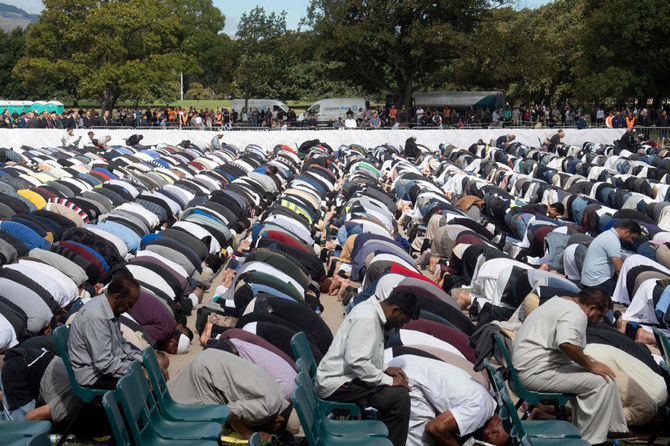CHRISTCHURCH, New Zealand: The Imam of Masjid Al Noor has led the first Jummah prayer in Christchurch since the mosque shootings last Friday.
The Friday Prayer was held at Hagley Park, directly across the road and about 100 meters from the mosque where a terrorist killed 42 worshippers.
Tens of thousands of people attended the Jummah prayer in a show of solidarity with the 50 victims of the shootings at two mosques in the city exactly a week ago.
Imam Gamal Fouda, who survived the attack at Al Noor mosque, faced the enormous crowd today, a sharp breeze carrying his words of prayer across the green park landscape.
“Last Friday, I stood in this mosque behind us and saw the hatred and rage in the eyes of a terrorist, who killed and martyred 50 innocent people, wounded 42 and broke the hearts of millions around the world. Today, from the same place, I look out and I see the love and compassion,” Fouda said.
“The terrorist tried to tear us apart with evil, but New Zealand is unbreakable.”
Fouda warned against the “evil ideology of white supremacy” saying it was a threat to man-kind globally.
“Islamophobia kills. Islamophobia is real. It’s a targeted campaign to influence people to dehumanize and irrationally fear Muslims.”
He called on governments and leaders around the world to bring an end to hate speech and the politics of fear.
Fouda said the world should look to New Zealand as an example of how to respond to right-wing extremism and terrorist attacks.
“The world can see in us an example of love and unity. We are broken-hearted but we are not broken. We are alive. We are together. We are determined to not let anyone divide us.”
Fouda thanked the public, the police and not least, the country’s prime minister Jacinda Ardern.
“Thank you for your tears. Thank you for your haka. Thank you for your flowers. Thank you for your love and compassion. To our prime minster, thank you. Thank you for your leadership. It has been a lesson for the world’s leaders. Thank you for honoring us with a simple scarf,” he said.
The imam’s words were punctuated throughout by spontaneous applause from the large crowd.
'The attack made us stronger'
Turkish man Mustafa Boztas said the mass gathering for Friday Prayer was comforting in the wake of the deadly attacks.

Mustafa Boztas was shot but survived the Christchurch mosque attack by playing dead. He attended Friday Prayers at Hagley Park, next to Masjid Al Noor, in a wheelchair. (AN photo by Steven Walton)
Boztas attended the event in a wheelchair. He was shot in the leg at Masjid Al Noor.
“Even if I couldn’t walk, I wanted to still make it here. I still can’t walk but I made it here,” Boztas said.
He said he survived the shooting by playing dead, then jumping out of a window to escape. There was a glass fragment in his rib and a problem with his liver.
Still, “You’ve got to stand up again and stay strong,” Boztas said.
He believed the terrorist attack had made the Muslim community stronger than ever.
'I lost my friend'
In a wheelchair and dressed in a hospital gown, Taj Mohammed Kamran came to worship at Hagley Park.
Kamran was shot in the leg at Masjid Al Noor last Friday and has been in Christchurch Hospital since.
He praised Imam Fouda’s speech, saying it had a “very good message”.
Kamran has lived in Christchurch for 12 years since arriving from Afghanistan. “I love the people of Christchurch," he said.
He recounted events in the mosque a week ago, explaining how he had tried to escape but couldn’t get out because there were too may dead bodies blocking the exits. His friend was shot and killed.
Kamram cried as he held up a photo of his close friend, Matiullah Safi, who was killed in the attack. The two “went everywhere together”. Safi was “like a brother”.
“I can’t sleep and I miss my friend,” Kamran said.



























